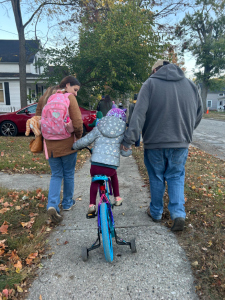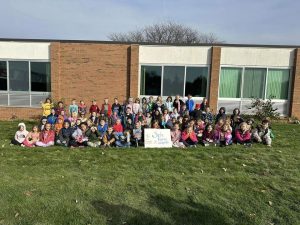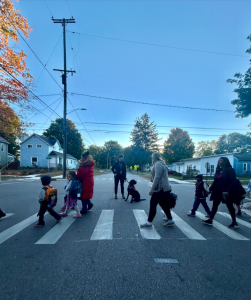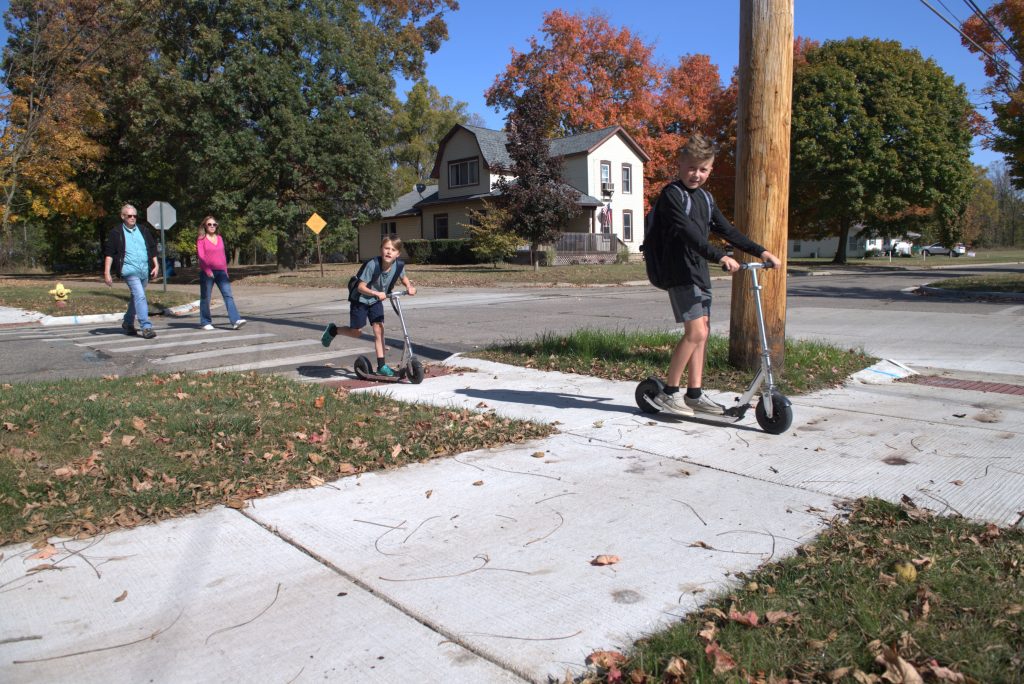
The City of Charlotte is home to a tight knit community with optimistic leaders. One such leader is AL!VE Community Wellness Manager Ellen Dreps who previously chaired a coalition to improve health and walkability in the community. AL!VE is a community wellness facility within University of Michigan Health-Sparrow Eaton.
To improve opportunities for active transportation in Charlotte, Dreps contacted the Safe Routes to School (SRTS) team at Michigan Fitness Foundation (MFF) in 2017 to build a Safe Routes to School project for the community. MFF’s SRTS team helped to get the ball rolling with technical assistance, as well as the planning and application processes to ensure a successful SRTS grant application.
Dreps forged a local SRTS team using her connections with Charlotte city officials, local schools, business owners, and other community stakeholders to improve walkability in the Mid Michigan town. The SRTS team then leveraged their connections to create robust community partnerships with AL!VE Community Health and Wellness Center, Charlotte Public Schools, and St. Mary School to carry out a city-wide and multi-district SRTS project.
Charlotte Public Schools Superintendent Dr. Mandy Stewart was another essential and key leader in this project and was supportive of pursuing the project from the initial ask.
SRTS grants allow funding to be used for improvements around schools within a two-mile radius. Fortunately for the small town of Charlotte, the entire city is within the two-mile radius from the project schools. This meant they were able to design a city-wide project that was in keeping with eligible grant funding.
With this in mind, walking audits were conducted throughout the entire city as part of the planning process. Reports showed many sidewalks in rough condition; some were crooked, some unmaintained, and others went nowhere. The audits also identified areas where sidewalks did not exist, causing students to have to walk through grass or snow to get to and from school. From the audit, they identified a gap without sidewalk along Lawrence Highway/M-79, and an issue identified with a rail crossing at Henry Street.
The Lawrence Highway/M-79 gap was missing sidewalks and a safe crossing point for students. Because it was within a Michigan Department of Transportation (MDOT) right of way, the Charlotte SRTS team secured project support from MDOT’s Lansing Transportation Service Center to help remedy the issues.
Stewart shared an observation about a significant gap identified north of the Charlotte Middle School and Charlotte Upper Elementary School campus.
“[In this area] students actually had to walk by a ditch through the grass. It’s not easy navigation for some of our younger people to actually access the school,” said Stewart.
For the SRTS application process, the Charlotte SRTS team needed preliminary design plans, and that meant they needed to raise funds to pay for the preliminary design-engineering costs. So, Dreps wrote a Capital Region Community Foundation grant.
“It was a huge, huge help to have a secondary grant on top of what we were going to be receiving for construction,” Dreps explained.
The SRTS project was not without its hurdles even with the extensive financial support and collaboration. Initial reactions were mostly positive, but there were a few that were less supportive. Several property owners had concerns about the impacts of the project. Dreps and Stewart both had techniques for responding to those concerned.
“We did a lot listening and explaining. Explaining how property works, how the city easements work, and what the city owns,” said Dreps. “And then sometimes we just listened, not explaining anything at all. They just have to get it off their chest. There were times that there’s not much you can say to make it better, but we tried to find a compromise whenever we could.”
“Kids need to be able to get to school safely,” explained Stewart. “When you’re driving, I don’t think you want to be looking around to make sure that there aren’t kids running around the street.”
Stewart emphasized the importance of communication throughout the early phases through various means, such as news articles, advertising, social media, board meetings, rotary meetings, and city council meetings.
“A lot of push out [of communications, information, and details]. The more communication, the better. If someone was concerned about the placement of a sidewalk, I was able to pull together a document of communications and opportunities to give feedback. That helped when there was resistance,” explained Stewart.
Stewart also spoke to the programming done by the schools to help students and families understand the benefits of the SRTS project. She described how the school’s mental health professionals, physical education teachers, and others helped spread this education.
“Explaining to students and having them realize that being outdoors and exercising is good for you. It’s good for your mental health. It’s good for your physical health. And that makes us all healthier as a community,” explained Stewart.
After the project was completed, attitudes began to shift. With access improved to schools, it also improved access around the city at large.
“We have kids come to AL!VE every single day from school for free wellness programs. I heard from students and parents how nice it is that they can safely get from the schools to AL!VE on sidewalks instead of the side of the road,” shared Dreps.
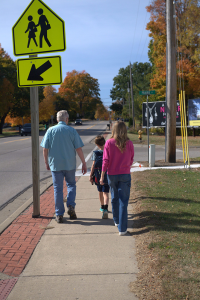
Active transportation around Charlotte increased as a whole, as did shifting attitudes about the project.
“I definitely see more dog walking, families with strollers, people utilizing the sidewalks,” observed Stewart. “I think the community really feels those benefits…when you walk around Charlotte now, you see a visible upgrade,” she expanded. “I met people who may not have been huge fans [of the project] all of a sudden waving at me, going, ‘This is so great. I can walk on either side of the street right now,’ and being really positive about what that did to their daily routines.”
The improvements have fostered community belonging and connection in new ways. Stewart shared an anecdote which ties community and infrastructure together and displays the value-added benefits of their SRTS project.
“The stretch down High Street. Right where they put the sidewalk in on the other side, whoever owns that empty lot built a whole garden and a little mosaic next to the sidewalk,” explained Stewart. “There were poppies and garden sculptures, and it just looks beautiful. Whoever owns that lot decided to beautify right next to the sidewalk… To me, that’s a community member.”
Further, the benefits of the SRTS project in Charlotte extend beyond the physical to the broader community, as the partnerships formed through the SRTS process have lasted and reached past the SRTS project. Stewart notes that the City of Charlotte and its community function with improved coordination after the SRTS process.
“For me personally, I got to know the people at AL!VE, people in city council, people who are in rotary, all of these different entities,” Stewart explained. “When we started working towards our bond project in 2020, and a renewal in 2022, I was able to reach out to those partnerships and say, ‘Hey, remember our working relationship and how we’re really focused on bettering our community? We also could use some support for aspects of our Bond project for the district.’ I felt like we got more support because we had those existing relationships built through the SRTS process.”
Approaching a SRTS project could be a dauting task for any community.
“I spun my wheels for a little bit. I had no idea what I was doing at first,” shared Dreps.
Yet, Dreps was able to be a key lead for Charlotte with the assistance of MFF’s SRTS team and the collaborative efforts of the larger project team. The long timeframe took patience and effort to navigate, but it was manageable and the end result were well worth it for the Charlotte community.
Project Impact:
This project filled gaps in a city-wide network of sidewalks, improving overall accessibility and mobility for all residents to school facilities. It provided safe walkable, bikeable, and rollable routes for Charlotte students, including key features of a railroad crossing and sidewalks along an MDOT road.
- MDOT/SRTS Total Infrastructure Budget: $1,333,149.64
- MDOT/SRTS Non-infrastructure Budget: $47,563
This project was made possible through the continuing collaborative efforts of the City of Charlotte, Charlotte Public Schools, St. Mary School, Eaton County Road Commission, Michigan Fitness Foundation, Michigan Department of Transportation, and Federal Highway Administration.

